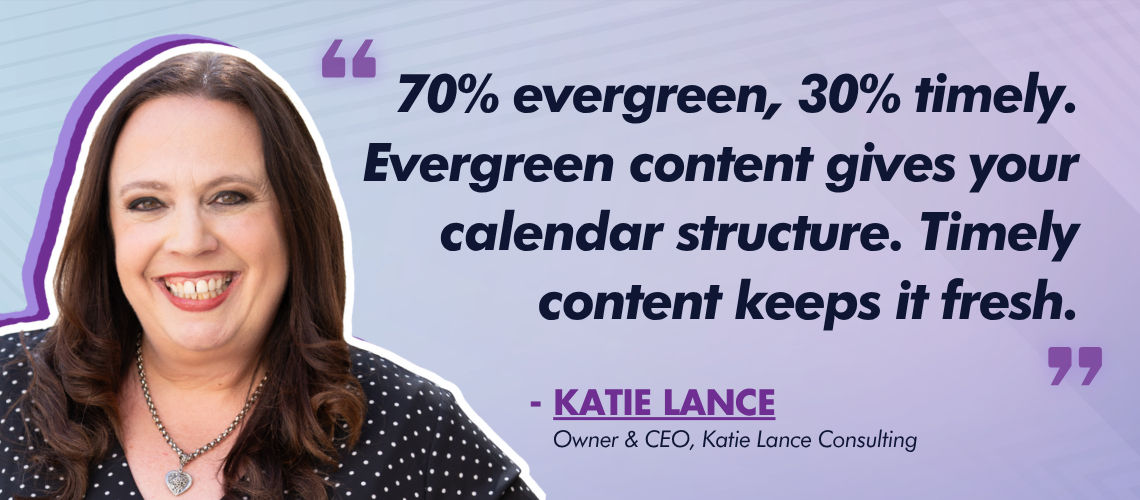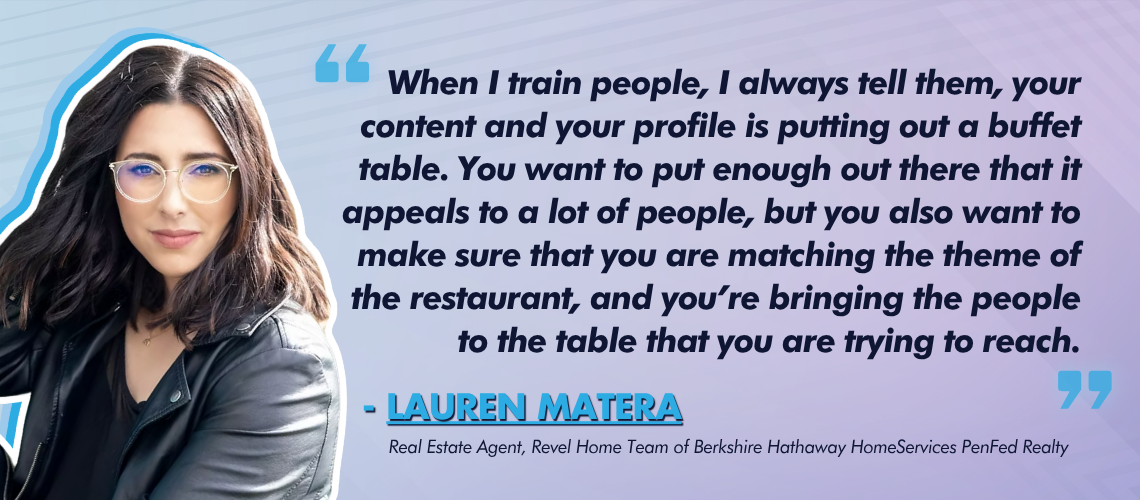Content creation is commonly cited as the most challenging aspect of social media marketing, so it’s no surprise that the vast majority of those using social media for business often hire someone who can dedicate their time and attention to what can only be described as a full-time job. Most real estate professionals, however, are working on their own to run and populate their social media accounts.
And while trying to run a profitable real estate business while creating a social media presence can be a daunting proposition, you can break down the walls by learning how to create attention-grabbing content; how and when to reuse content and repurpose ideas; how to batch content; and how to maintain your authenticity.
Content that captures attention
Anyone can make content and post it on social media, but creating high-quality content that grabs attention and breeds engagement is a whole other story.
There’s an easy way to help you focus your efforts, which begins with breaking content down into two specific categories: visual and informational. Understanding these basic content types will go a long way toward helping you develop a creation strategy that will breed strong metrics across your socials.
Visual content centers on photo and video content—not graphic design. This is where you’ll do the bulk of advertising for your real estate business. Visual content in the real estate realm often focuses on home tours, client testimonials and personal content such as agent stories as well as behind-the-scenes footage. You’ll be advertising both yourself and your business in these types of posts in order to draw in potential clients. You’re showing off your products (yourself and your listings), your good reviews (testimonials) and your work ethic (personal content).

When creating visual content, be sure to incorporate both photos and videos, as this will make it easy to share your content across a variety of social media platforms. For instance, the photos you take when touring a home can be shared on Instagram, while that same content can be shared on TikTok via a video walkthrough.
Read More: Social Skills: A Guide to Visual Content on Your Socials
Informational content, on the other hand (which can include visuals), will mostly center on text-based mediums like infographics. This is where you share your knowledge and expertise to educate potential clients, building your trust and reputation along the way. Your informational content will focus on breaking down market updates in addition to sharing buying/selling and homeownership tips with friends and followers alike.
Think of market updates as providing the ability to not only demonstrate your knowledge and understanding of the real estate market—from a hyperlocal standpoint all the way to the national level—but to build your reputation with past, present and future clients as someone who knows what they’re talking about. Sharing buying/selling and homeownership tips will help you further build trust with potential clients by showing your ability to guide and give advice—something buyers and sellers look for when choosing an agent to guide them through the buying and selling journey while educating them about the real estate process.
Read More: Powering Your Socials With Interesting Infographics
Reusing and repurposing
Since social media is most likely not at the top of your list, or the first thing that gets pushed to the back burner as you go through your day-to-day routine as a real estate professional, you’ll almost never have enough time to create enough content to completely populate your social media accounts. But there’s an easy solution if you find yourself in this situation: reusing and repurposing content.
One of the big questions here is what to repurpose? Lance points out that any content you share that does fairly well metrics-wise—lots of saves, comments, shares or good feedback—is “a signal to reuse it.”
“Also, if the content answers a common question from clients like, ‘How do I stage my home to sell?,’ I know it has long-term value,” she says. “One-and-done content is usually tied to something ultra-specific or time-sensitive, like a live open house or date-specific news.”
Lauren Matera—an agent, trainer and content creator with over 400k social media followers—says that her own social media strategy involves reusing past content, but with some specific guidelines.
Like Lance, she says that anything really popular is an easy repost, but something you have to sit back and evaluate by asking, “am I even on that same path anymore?” is content you should avoid reusing.
Breaking this concept down further, Matera notes that if the content you want to repost has a completely different vibe than what you’ve been creating lately—or what your brand is nowadays—is it worth the disruption just for some extra engagement?
You should only reuse content “as long as it’s in alignment with what path you’re on now,” emphasizes Matera.
Another way to reuse content involves repurposing ideas and content themes you’ve used in the past to create new pieces of content, essentially turning one piece of content into many.
“I’ll break the content up into different parts or segments,” explains Matera, citing a recent rodent sighting in her garage as a prime example of the way she can “stretch content” to get multiple posts out of one idea.
“I had a rat in my garage that I just thought was really funny,” she says. “I could have done a cute little minute-long video and been done with it, but I think there are nine parts to it on my TikTok because it was so relatable and funny to everybody. So I just kept it going until the engagement slowed.”
The main thing to keep in mind when repurposing ideas is to not simply re-hash the previous content. Lance clarifies that you want to “reframe the angle or tell a new story around the same topic.”
“For example, instead of reposting the same staging tips, share a new before-and-after from a recent listing,” she says. “Also, shift formats. What was once a blog can become an Instagram Reel, then a carousel. Your audience doesn’t remember as much as you do, so don’t be afraid to revisit great content with a fresh twist.”
Repurposing “isn’t about doing more,” adds Lance. “It’s about getting more from what you’ve already created.”
Batch creating content
Another way to easily populate your social media accounts is to batch create content.
When you set out to generate content during a previously scheduled block of time, or you have a sudden burst of creativity and decide to produce something on the fly, create multiple posts within that time period.
One of the best ways to batch create content is to turn one piece of content, or one idea, into many. To start, if you set out with the intention of making a few different photo-based posts, you can also record videos for additional posts down the line. From there, you can create blog posts out of ideas featured in your photo and video content before creating email newsletters out of those blog posts. The cascade goes on and on.
“A five-minute clip can become three to four (Instagram) Reels, two to three carousels (of photos) and a few stories when you think intentionally about how people consume content differently,” says Lance, who recently filmed a YouTube video on “How to Plan a Year of Content in One Day,” and made multiple pieces of content out of that one idea.
“From that one topic, I created a YouTube video, an Instagram carousel, 60-second Reels/TikToks, a blog post/newsletter for LinkedIn, an email newsletter, a podcast episode, an in-depth training inside our #GetSocialSmart Academy and a webinar replay for members,” she says. “That’s the magic of leading with one strong idea and tailoring it to different platforms and formats.”
Something to keep in mind, however, is to not let your content become too formulaic when you batch. Matera warns that if you become too scheduled, you can lose the creativity and “off the cuff” nature of your content, thereby losing authenticity in your brand. To that end, she recommends batching when you have ideas you want to share with your audience rather than over-scheduling creation time.
“I try to batch if I have ideas to get done, and I try to execute to the best of my ability while keeping things natural and genuine,” she says. “If I do have specific ideas, that’s what I batch. I don’t really want to stand in my office anymore and force myself to make three videos.”
Keeping the authenticity
No matter what kind of content you’re posting—new, reused or repurposed—and how you’re creating that content, the main thing to keep in mind is being authentic.
Most businesses using social media to market are selling products, but as a real estate professional, you’re selling yourself. Sure, your listings are technically a product, but you’re ultimately selling yourself to potential clients. You want people to connect with you and hire you.
In order to do that, you have to bring your personality forward within your content, and maintain it no matter what. The key is to balance this with creating content that targets your intended audience(s).
“When I train people, I always tell them, your content and your profile is putting out a buffet table,” says Matera. “You want to put enough out there that it appeals to a lot of people, but you also want to make sure that you are matching the theme of the restaurant, and you’re bringing the people to the table that you are trying to reach.”
One big opportunity many real estate professionals may face when they have the funds to hire assistants to take some work off their plate is being tempted to hire a social media assistant to run their accounts. This is something Matera says to avoid, as it can hinder the authenticity of your brand.
“It becomes so managerial, so specific. People can tell it’s not you,” she says. “With the kind of content we create, it’s not a business page selling products. It’s just me, and your pages are just you. It would be very hard for somebody to come in and duplicate or replicate personality on posts.”

Matera recommends spending the money on assistants for other aspects of the business, like a transaction coordinator, in order to free up your time to work with clients and work on your social media. You can also hire account managers to post and do analytics, but not to create the content itself.
The best way to free up your time while maintaining your authenticity is to pursue helpful tools and technology. While there are a wealth of marketing tools designed to help you create content and run your social media, Lance recommends tools such as Canva for creating graphics, Descript for editing videos and Captions.AI for short video editing with on-screen text.
Lemons-Ryhal also strongly recommends pursuing AI as an assistant of sorts for your social media efforts. Tools like ChatGPT can help transcribe and create blog posts out of videos, turn blog posts into video or infographic content, generate ideas and captions, analyze metrics and more.
Read More: Social Skills: AI Tools to Take Advantage of in Your Marketing



